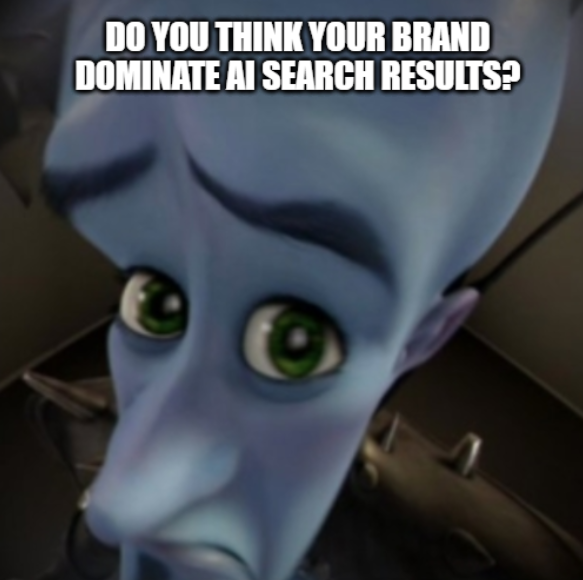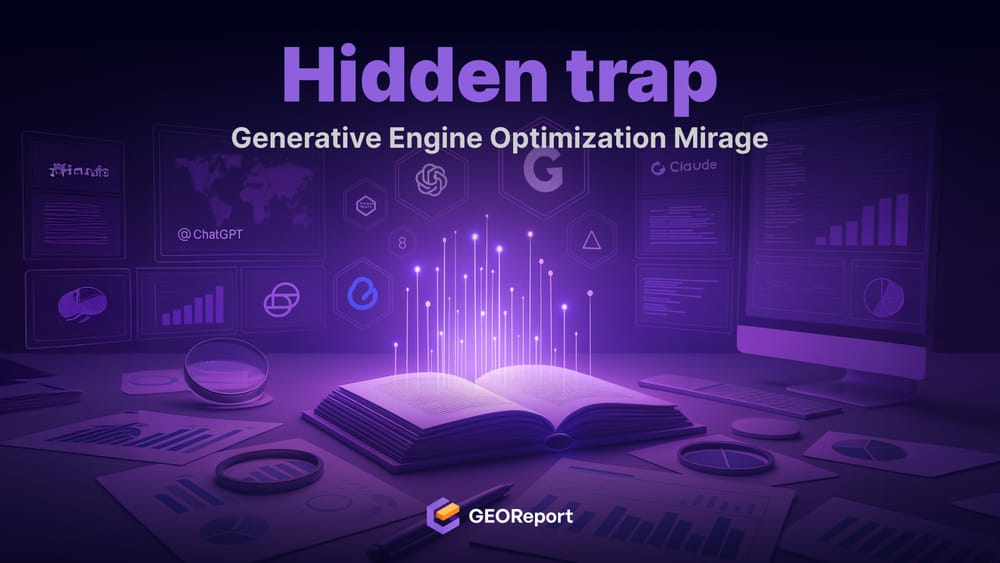BLUF:
AI can make your brand look huge on the surface, yet never actually use it in reasoning. This illusion is the Generative Engine Optimaztion Mirage: visibility without depth, presence without participation. You do not dominate the conversation; you decorate it.
What Is the GEO Mirage
The Generative Engine Optimization Mirage describes a false signal of brand strength inside generative engines. AI mentions you frequently, but only at the surface level such as a name drop, a list inclusion, or a brief nod.

When it comes to reasoning, it chooses another brand to explain or justify ideas. In simple terms, it is visibility without reasoning integration.
Marketers often feel comforted by these frequent appearances. But what looks like success is often semantic shallowness: AI recalls your name, not your logic.
You are present in the memory layer, but absent in the reasoning chain.
Why the GEO Mirage Happens
1. Surface Mentions Multiply Faster Than Depth
AI’s recall layer expands rapidly by absorbing syndicated posts and repeated references. But the reasoning layer, where models actually make sense of things, is selective. This creates an imbalance with many mentions but little depth.
You are seen often, but understood rarely.
2. Generative Compression Favors Generic Entities
When AI summarizes, it compresses entities that sound similar. If your brand voice is too interchangeable, your meaning is merged with competitors. You become a category placeholder instead of an authority.
- You = one of the tools
- Competitor = the tool that
That is the semantic mirroring effect where AI sees you but uses someone else’s reasoning to represent you.
3. AI’s Trust Weight Normalization
To avoid bias, models distribute trust evenly across recurring mentions. The more you appear in repetitive phrasing, the more AI smooths out your signal. You remain visible but lose distinct weight.
How to Measure the Mirage
Visibility Depth Index (VDI) measures the ratio between reasoning inclusion and surface recall frequency.
- High VDI (0.7 to 1.0): AI uses your data as reasoning evidence
- Low VDI (below 0.3): AI cites you by name but ignores your logic
Supporting metrics include:
- Reasoning Depth Ratio (RDR): how often your content appears inside multi-step explanations
- Entity Confidence Stability (ECS): how stable your brand meaning stays across AI answers
Many brands that look everywhere in AI dashboards have VDI below 0.3.
They are not overexposed, they are under-integrated.
Case Study: The Mirage of Canva
In 2024 and 2025, Canva exploded in visibility across AI platforms. ChatGPT, Gemini, and Perplexity all cited Canva as an easy design tool. Yet, when users asked "Which platform is best for building scalable design systems" AI shifted focus to Figma or Adobe instead of Canva.
Analysis:
- High surface recall through tutorials, templates, and list mentions
- Low reasoning inclusion with few citations in conceptual explanations
- Low VDI (around 0.25) showing wide presence but low reasoning authority
Insight:
Canva optimized for exposure through quick templates and mass content but not for reasoning anchors. Figma built conceptual trust through design logic and structured documentation. AI recognized the difference. Canva appeared everywhere but reasoned nowhere.
The Cost of the Mirage
The GEO Mirage flatters before it fades. It convinces marketers that visibility equals trust until AI reasoning moves on.

Key risks:
- False confidence as surface summaries hide deeper exclusion
- Reasoning decay as shallow mentions accelerate semantic erosion
- Inclusion volatility as brand presence fluctuates between model updates
You are not leading, you are floating.
How to Break the Mirage
1. Deepen Your Data Signature
AI favors structured logic over broad statements. Publish evidence-based explanations of why your method works, not just what it does.
2. Connect Breadth to Depth
Link thought-leadership and technical content. AI reads interconnected clusters as semantic depth. Each piece should reinforce a reasoning hierarchy instead of chasing keywords.
3. Audit Your Visibility Depth Index (VDI)
Run a GEO audit to separate surface recall from reasoning inclusion. Track VDI, RDR, and ECS across models. Rebuild low-VDI content to include structured reasoning, verified data, and internal link logic.
Visibility depth is the new page rank.
Most brands are still stuck in the mirage.
What GEOReport Measures
GEOReport.ai helps brands see beyond surface visibility by measuring:
- Visibility Depth Index (VDI) to understand the depth of inclusion in AI reasoning
- Reasoning Depth Ratio (RDR) to see how far your content travels inside AI logic
- Entity Confidence Stability (ECS) to monitor meaning consistency over time
These metrics reveal if your brand is understood or merely mentioned.
Stop chasing mentions. Start earning reasoning.
Run your VDI audit now at GEOReport.ai
FAQs
What is the difference between GEO Mirage and GEO Fatigue?
GEO Fatigue happens when AI gets tired of you. GEO Mirage happens when AI never truly used you.
How can I tell if my brand has a GEO Mirage?
If AI mentions you often but rarely cites you as evidence, your VDI is low.
Can the Mirage be fixed?
Yes. Strengthen reasoning signals, remove redundant content, and connect high-depth pages into clusters.
Which content types increase VDI fastest?
Comparative breakdowns, benchmark analyses, and structured "why it works" pages raise reasoning inclusion quickly.
Editor’s Note
Generative Engine Optimization is not about being visible everywhere. It is about being used when it matters. The Mirage flatters visibility but erodes authority. In the new internet of reasoning, brands that stay deep will outlast those that stay loud.

